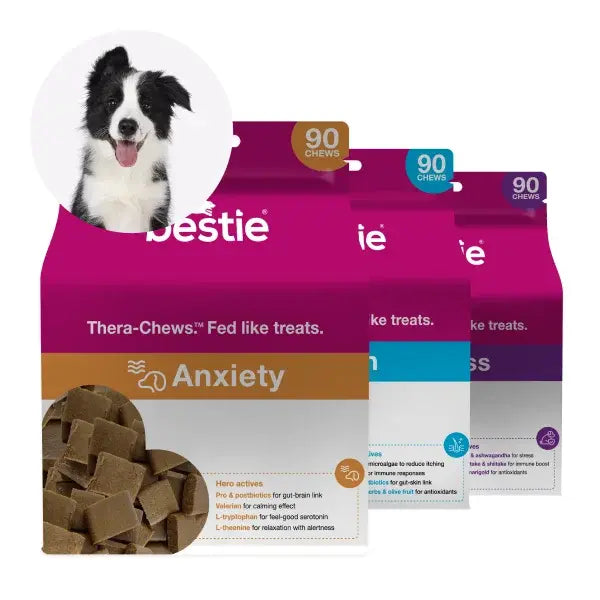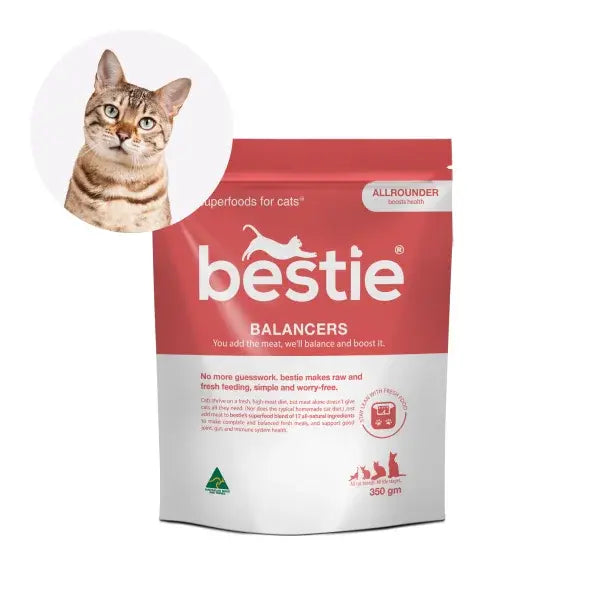As dogs age they often start to become less physically active. This doesn’t necessarily mean they should also become less mentally active too!
It might look like an older dog doesn’t appear to have a need for walking, playing or training but in fact, research has shown that senior dogs reap many benefits from pet parents helping their senior dogs to continue these activities, albeit a little differently.
In this article we will talk about the various ways pet parents can provide enrichment for their senior dogs, categorised into the following groups:
- Sensory enrichment
- Environmental enrichment
- Cognitive and social enrichment
Before we get started, some definitions. Just when is my dog considered a senior?
The age at which our furry friends are referred to as seniors roughly depends on their size, in general:
- Small breeds: 10-12 years
- Medium breeds: 8-9 years
- Large or giant breeds: 6-7 years
Enrichment for dogs refers to any activity or environment which improves a dog’s mental state by exercising and testing their brain. Not only do our senior dogs enjoy enrichment but, studies have shown it to have many benefits including:
- Being a contributing factor in reducing the chances of them suffering from cognitive decline, you can read more about this in our article ‘Doggy dementia’.
- Improving their quality of life, especially those who aren’t able to move as much anymore or those who suffer from long term diseases.
- Maintaining the strength of the pet parent dog bond.1
Before we go into the specifics of each category, here are some general points to help pet parents get started:
- Keep enrichment fun- in the case of an enrichment activity, let our furry friends decide for themselves if they want to participate and when it’s time to call it a day. Pet parents can tell how their furry friends feel about a task by looking at their dog’s body language.
- Make enrichment yummy - pet parents can offer some positive reinforcement during or after the enrichment by offering them their favourite treats.
- Build up slowly - start with smaller age-related changes in a senior dogs environment or activity difficulty level and progress over time
- Choose according to personality - our furry friends are all different, choose tasks which play to their strengths to avoid them getting confused, even the most determined type can sometimes become too tired or frustrated, which takes away any benefit from an enrichment activity.
- Accommodate their physical ability and comfort - for example, if an older dog suffers from arthritis, pet parents can provide a mat to decrease the chances of them slipping when performing a task. Keep activities short so they don’t get too tired and let them have a long rest in between.
If you’re not sure whether a change or activity is suitable for your older dog (especially if they have a health condition) you can chat about it with your vet.
Sensory
Often our senior dogs don’t have as efficient sight or hearing as they did when they were younger. But, this isn’t necessarily a problem when it comes to enrichment, it just means that it’s best for pet parents to choose activities which take any age related changes into account.
For example, when choosing enrichment activities for pets who are hard of hearing, pet parents should try to focus on tasks to stimulate their sight, smell and taste. If, however, their sight is more of a problem it’s probably better to focus on their smell, taste or hearing.
Snuffle mats can be a great way for a dog hard of hearing and or sight to exercise their senses by digging and sniffing for their favourite treats hidden inside by their pet parents.
Pet parents can also enjoy the enrichment activities of their pets by getting creative and making activities such as:
- Homemade enrichment boxes using scrunched newspapers or toilet rolls
- Snuffle mats using the rags of old t-shirts
- Hiding treats under cupcake liners with tennis balls to move out of the way
- Puzzle feeders using plastic bottles with holes in or plastic cups drawn out on a string to upturn for treats
- Scavenger hunts with lists of objects to find on their next walk
For pet parents who prefer to purchase readily made enrichment activities, ice trays or lick mats (filled with mashed dog food or peanut butter), Kong and other chew or digging toys can be bought from pet shops, and give the same benefits as homemade ones.
These types of games or puzzles provide sensory and environmental enrichment and are especially nice for older dogs who have chronic painful conditions (such as arthritis) meaning they can’t walk very far or at all.
Environmental
Enrichment for our senior furry friends involves making their living environment accommodating for any decreased ability to eat, move, socially interact and play.
It’s good to keep our senior furry friends involved in as many aspects of our family lives as they still enjoy. At the same time, older dogs also often also benefit from a special ‘low stress’ area where they can take time out when they need to.
Characteristics of suitable ‘low stress’ areas for our senior furry friends include:
- Places they can have peace and avoid unwanted contact with other pets (especially younger ones) and members of the family.
- A cosy bed to rest in with plenty of padding
- Different areas with varying comfortability and isolation
- Areas they can access easily without any assistance at any time of day, (without any steps) on the level they spend the most time and without going over slippery surfaces.
- Safe and stress-free access to their food and water
- Access to their toys
- Barriers to block out visual threats
If it is essential for senior pets to climb stairs, pet parents can think about the use of a pet friendly ramp. Some of our four-legged friends may also find a mirror in their environment enriching, but others can also find it a bit scary. Pet parents can be the judge!
Dogs who suffer from progressive blindness are sometimes able to cope well with their loss of sight. If they can maintain their memory of their environment, they can often safely navigate their home without too many collisions.
Senior dogs who aren’t able to see as well as previously will therefore appreciate environmental changes (such as the location of furniture) to be kept to a minimum.
In a similar way, our older pets often prefer a regular routine and travel to be kept to a minimum. Their regular routine also includes using the same entry and exit points for toilet breaks to better help a senior dog show when they want to go outside.
It is also better for their feeding and walking schedule to be consistent and for them to have permanent access to all the areas they may need for eating, sleeping, going to the toilet and low stress areas.
Rather than a senior dog going to a boarding kennel when their pet parents go away, they probably prefer to have someone come to the house to look after them so they can maintain their usual routine.
Dogs who suffer from separation anxiety as they get older may also benefit from the use of doggy music or videos whilst their pet parents are away.
Facilitating their environment also extends to helping them on walks. Older pets often prefer the use of a harness which can also have a backend if they need extra support.
Cognitive and social
Continuing to train and communicate with senior dogs is a good way to maintain good mental health for them and to help them perform their normal behaviour. It’s best if this training and use of commands in the same way as the enrichment activities we mentioned earlier, also plays to their strengths.
For example, if they have problems with their hips or back, perhaps avoid asking them to sit and get their attention using a ‘watch me’ cue.2 In dogs who are short of sight, the use of sound (such as whistling) can help pet parents to show their senior dogs when they want their attention.
When taking our furry friends who are short of sight into new environments (for example when on walks) it can be beneficial to talk to them constantly so they know where to go based on the sound of familiar voices. For our senior dogs with hearing difficulties, hand signals are often also easier to follow.
Senior furry friends who still have the ability to move well, may also enjoy swimming in shallow, algae free areas or in designated doggy swimming facilities, with the use of a lifejacket.
Shorter sniff walks are a great way to combine a balance of exercise for a senior dog’s mind and their body. This opportunity to express their natural behaviour also provides cognitive and sensory stimulation they are sure to enjoy!
For our more social seniors, social enrichment can also be combined during walks. The opportunity to meet and gently play with new friends in a safe environment can provide positive experiences and enrichment which improve their quality of life and mental status. Another way is to organise play dates with other pet parents with well matched older or calm dogs.
Social enrichment can also be at home when pet parents enjoy down time together with their senior dog. Perhaps they still enjoy cuddles on the sofa or may be content just to remain by the side of their pet parents
Charlotte Franscesca Stiles

Charlotte is a 5th-year veterinary medicine student at the University of Zagreb, Faculty of Veterinary Medicine. She is a volunteer at her university's obstetrical clinic, equine clinic, an editor of her university's scientific journal, and dog mum to 12-year-old Chiki.
Charlotte is particularly interested in wildlife medicine and research and hopes that her current extra-curricular work as a student in this area will help her achieve a scientific career after graduation.
References
1.Wallis, L. J., Range, F., Kubinyi, E., Chapagain, D., Serra, J., & Huber, L. (2017, November). Utilising dog-computer interactions to provide mental stimulation in dogs especially during ageing. In Proceedings of the Fourth International Conference on Animal-Computer Interaction (pp. 1-12).
2.https://veterinarypartner.vin.com/default.aspx?pid=19239&catId=102897&id=10506122
3.Treatment and Care of the Geriatric Veterinary Patient, Mary Gardner, Dani McVety, 9 June 2017,SBN:9781119187219















